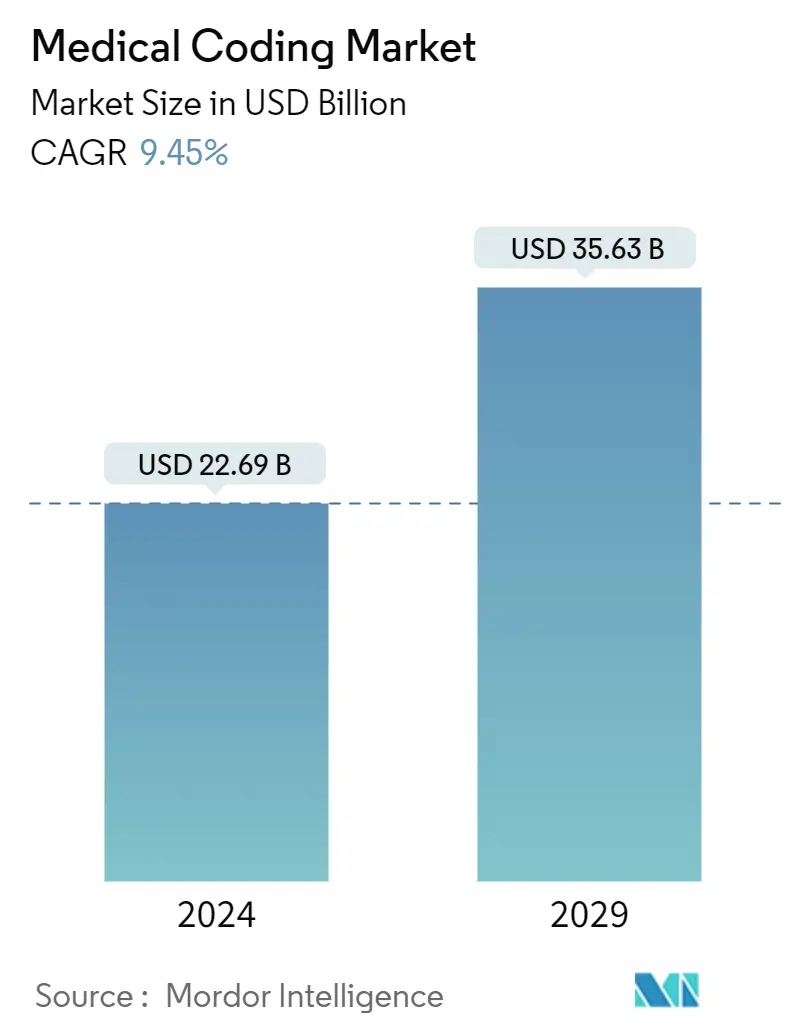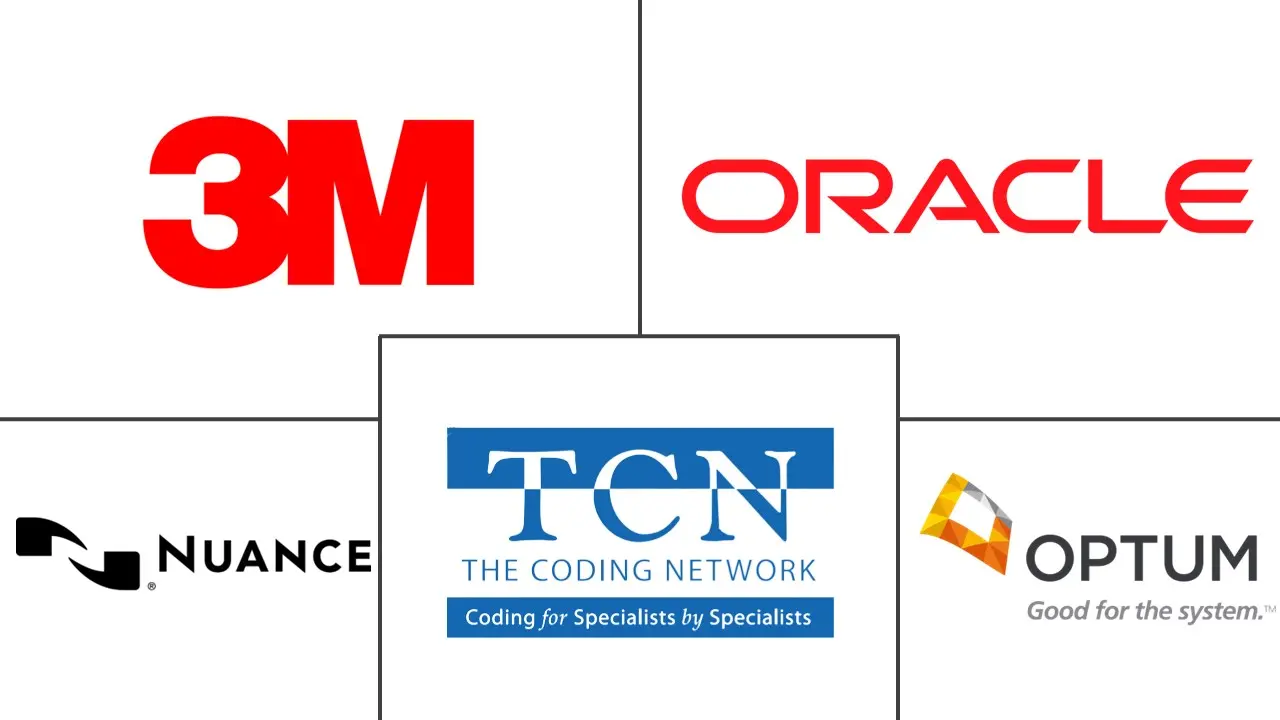Market Size of Medical Coding Industry

| Study Period | 2021 - 2029 |
| Market Size (2024) | USD 22.69 Billion |
| Market Size (2029) | USD 35.63 Billion |
| CAGR (2024 - 2029) | 9.45 % |
| Fastest Growing Market | Asia Pacific |
| Largest Market | North America |
| Market Concentration | Medium |
Major Players
*Disclaimer: Major Players sorted in no particular order |
Medical Coding Market Analysis
The Medical Coding Market size is estimated at USD 22.69 billion in 2024, and is expected to reach USD 35.63 billion by 2029, growing at a CAGR of 9.45% during the forecast period (2024-2029).
The factors responsible for the growth of the market include the escalating demand for coding services, the rising need for a universal language to reduce frauds and misinterpretations associated with insurance claims, and the high demand for streamlining hospital billing procedures.
The demand for coding services is significantly increasing owing to the rise in medical admissions. For instance, as per the American Hospital Association's (AHA) Hospital Statistics 2024, there have been around 34 million admissions in all the hospitals in the United States so far in 2024. The high number of hospital admissions raises the demand for skilled medical billers and coders to manage medical billings, which is anticipated to catalyze the growth of the medical coding market over the forecast period.
There's a growing inclination within the medical coding market to transition toward a more efficient and user-friendly coding and billing solution that offers streamlined processes and enhanced convenience. This, in turn, is increasing the demand for skilled medical coders professionals in the market. For instance, according to a report published by the Association of American Medical Colleges in February 2024, the demand for medical coders is high. It continues to rise due to the historic shift in age demographics in the United States. This growth of the older population poses healthcare challenges, including an anticipated shortage of 105,000 physicians by 2030. Additionally, according to the Bureau of Labor Statistics (BLS), in September 2023, the BLS projected an 8% increase in medical records and health information technician positions, including medical billers and coders, between 2022 and 2032. Thus, the rising demand for medical coders underscores the imperative for an efficient, user-friendly coding and billing solution to address healthcare challenges effectively.
Medical coding facilitates standardized documentation across healthcare facilities, enabling administrators to analyze the frequency and efficacy of treatments within their organization. This capability is especially crucial for large-scale medical institutions such as tertiary-care hospitals.
Advancements in coding software are expected to help clinicians effectively manage the large amount of data across healthcare facilities. For instance, in July 2023, Amazon Web Services Inc. (AWS) launched AWS HealthScribe. This new HIPAA-eligible service empowers healthcare software providers to build clinical applications that use speech recognition and generative artificial intelligence (AI) to save clinicians time by generating clinical documentation. Thus, the introduction of advanced clinical documentation technology leveraging speech recognition and generative AI is poised to drive significant expansion in the medical coding market over the forecast period.
Major players in the market are introducing new products to cater to the rising demand for medical coding, which is further expected to propel the market growth. For instance, in December 2023, the new PULSE technology, a landmark and transformative SaaS product, was launched by CorroHealth for the healthcare industry, advancing and forever changing how hospitals and clinics code and recover revenue. PULSE is an innovative medical coding automation platform designed to streamline and expedite the coding process. This automated solution significantly boosts productivity in fee-for-service and value-based care scenarios, providing substantial benefits to healthcare organizations.
There has been a high demand for investments in medical billing and coding software programs that can lead to long-term financial benefits and a positive return on investment (ROI) to its major investors. For instance, in March 2023, CodaMetrix, an AI-powered platform for healthcare revenue cycle management, secured USD 55 million in Series A funding led by SignalFire. The company utilizes machine learning, natural language processing, and deep learning to analyze electronic health records for autonomous medical coding.
Thus, the escalating demand for coding services and the high demand for streamlining hospital billing procedures are expected to propel the market's growth. However, continuously changing regulations, data security concerns, and the need for adequately equipped information technology (IT) professionals in the healthcare sector are expected to hinder the market's growth.
Medical Coding Industry Segmentation
Medical coding transforms healthcare diagnoses, procedures, services, and equipment into universal medical alphanumeric codes. Medical coding is increasingly used in the present scenario to create a proper patient care record, streamline the medical billing process, accelerate payments to physicians, and identify the healthcare areas requiring focus.
The medical coding market is segmented by classification system, component, end user, and geography. By classification system, the market is further segmented into the international classification of diseases and the healthcare common procedure code system. By component, the market is further segmented into in-house and outsourced. By end user, the market is further segmented into hospitals, diagnostic centers, and other end users. By geography segment, the market is further segmented into North America, Europe, Asia-Pacific, the Middle East and Africa, and South America. For each segment, the market size is provided in terms of value (USD).
| By Classification System | |
| International Classification of Diseases (ICD) | |
| Healthcare Common Procedure Code System (HCPCS) |
| By Component | |
| In-house | |
| Outsourced |
| By End User | |
| Hospitals | |
| Diagnostic Centers | |
| Other End Users |
| Geography | ||||||||
| ||||||||
| ||||||||
| ||||||||
| ||||||||
|
Medical Coding Market Size Summary
The medical coding market is poised for significant growth, driven by the increasing demand for coding services and the need for standardized documentation across healthcare facilities. This demand is fueled by the rise in medical admissions and the necessity for a universal language to mitigate fraud and misinterpretations in insurance claims. The market is witnessing a shift towards more efficient and user-friendly coding and billing solutions, which is amplifying the need for skilled medical coders. Technological advancements, such as the introduction of AWS HealthScribe and CorroHealth's PULSE technology, are enhancing the efficiency of coding processes, thereby supporting market expansion. The market is also experiencing a surge in investments in medical billing and coding software, which promise long-term financial benefits and a positive return on investment.
The International Classification of Diseases (ICD) segment is expected to hold a significant share due to the widespread prevalence of chronic and infectious diseases, necessitating effective management through standardized coding. The market's growth is further supported by the rising burden of chronic diseases, such as cardiovascular conditions and cancer, which require precise and comprehensive medical coding solutions. North America is anticipated to maintain a substantial market share, bolstered by technological advancements and improved healthcare infrastructure. The competitive landscape is characterized by the presence of numerous local and international players, all striving to enhance their market presence through innovative technologies and strategic partnerships.
Medical Coding Market Size - Table of Contents
-
1. MARKET DYNAMICS
-
1.1 Market Overview
-
1.2 Market Drivers
-
1.2.1 Escalating Demand for Coding Services
-
1.2.2 Rising Need for a Universal Language to Reduce Frauds and Misinterpretations Associated with Insurance Claims
-
1.2.3 High Demand to Streamline Hospital Billing Procedures
-
-
1.3 Market Restraints
-
1.3.1 Changing Regulations Related to Medical Coding
-
1.3.2 Data Security Concerns
-
1.3.3 Lack of Adequately Equipped IT Professionals
-
-
1.4 Porter's Five Forces Analysis
-
1.4.1 Threat of New Entrants
-
1.4.2 Bargaining Power of Buyers/Consumers
-
1.4.3 Bargaining Power of Suppliers
-
1.4.4 Threat of Substitute Products
-
1.4.5 Intensity of Competitive Rivalry
-
-
-
2. MARKET SEGMENTATION (Market Size by Value - USD)
-
2.1 By Classification System
-
2.1.1 International Classification of Diseases (ICD)
-
2.1.2 Healthcare Common Procedure Code System (HCPCS)
-
-
2.2 By Component
-
2.2.1 In-house
-
2.2.2 Outsourced
-
-
2.3 By End User
-
2.3.1 Hospitals
-
2.3.2 Diagnostic Centers
-
2.3.3 Other End Users
-
-
2.4 Geography
-
2.4.1 North America
-
2.4.1.1 United States
-
2.4.1.2 Canada
-
2.4.1.3 Mexico
-
-
2.4.2 Europe
-
2.4.2.1 Germany
-
2.4.2.2 United Kingdom
-
2.4.2.3 France
-
2.4.2.4 Italy
-
2.4.2.5 Spain
-
2.4.2.6 Rest of Europe
-
-
2.4.3 Asia-Pacific
-
2.4.3.1 China
-
2.4.3.2 Japan
-
2.4.3.3 India
-
2.4.3.4 Australia
-
2.4.3.5 South Korea
-
2.4.3.6 Rest of Asia-Pacific
-
-
2.4.4 Middle East and Africa
-
2.4.4.1 GCC
-
2.4.4.2 South Africa
-
2.4.4.3 Rest of Middle East and Africa
-
-
2.4.5 South America
-
2.4.5.1 Brazil
-
2.4.5.2 Argentina
-
2.4.5.3 Rest of South America
-
-
-
Medical Coding Market Size FAQs
How big is the Medical Coding Market?
The Medical Coding Market size is expected to reach USD 22.69 billion in 2024 and grow at a CAGR of 9.45% to reach USD 35.63 billion by 2029.
What is the current Medical Coding Market size?
In 2024, the Medical Coding Market size is expected to reach USD 22.69 billion.

